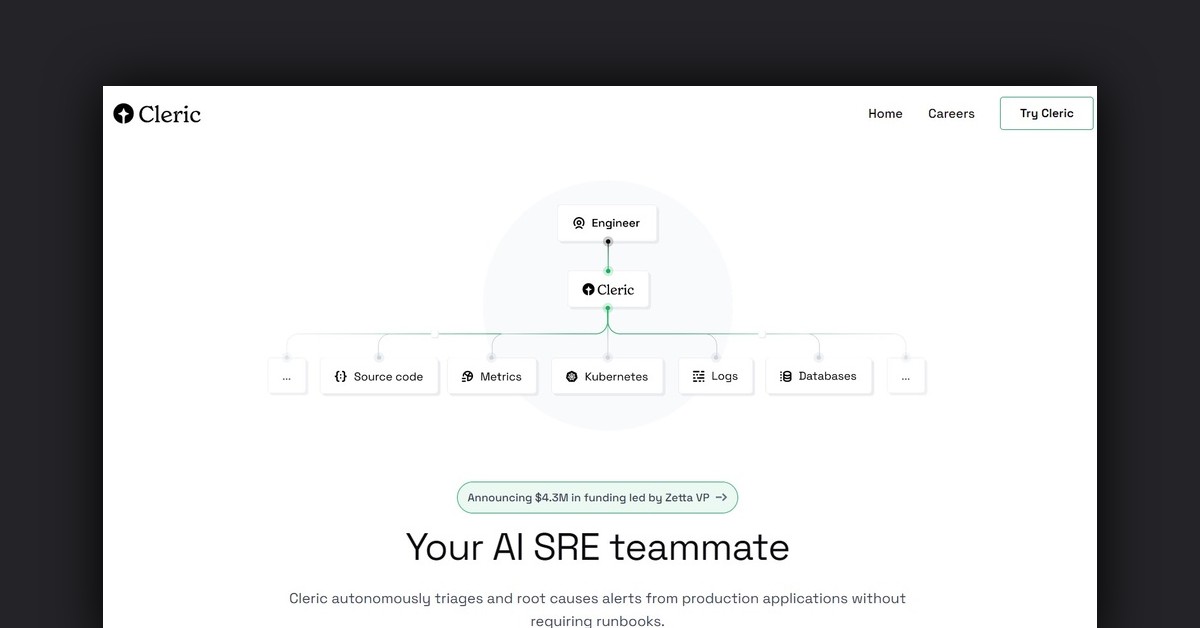Revolutionizing Infrastructure Management with Cleric AI
In today’s rapidly evolving software landscape, efficiently managing and troubleshooting production environments has become a significant challenge for software engineering teams. Introducing Cleric, a groundbreaking AI-powered solution that is transforming the way teams handle on-call responsibilities and optimize their infrastructure.
How Cleric Works
Cleric introduces a revolutionary approach to application issue troubleshooting by employing an autonomous AI agent. This AI teammate operates without the need for traditional runbooks, autonomously triaging alerts, prioritizing critical issues, and investigating problems by collecting relevant evidence to propose a root cause. Cleric’s unique ability to understand natural language and interact with various tools via APIs makes it an invaluable resource for software engineers.
Key Cleric functionalities include:
- Autonomous Investigation: Cleric’s AI agent automatically investigates alerts, saving engineering teams hours of manual work.
- Critical Alert Prioritization: Cleric identifies and focuses on the most high-impact problems, ensuring efficient problem-solving.
- Intelligent Runbook Execution: Cleric executes the most appropriate runbook, utilizing first-principles reasoning when necessary.
Features, Functionalities, and Benefits
Cleric is not just a troubleshooting tool; it’s a comprehensive solution that aims to transform infrastructure management. Here’s how it benefits your operations:
- Efficiency: Cleric drastically reduces the time spent on diagnosing and resolving issues, freeing up valuable engineering resources.
- Focus: By offloading on-call duties, Cleric allows engineers to concentrate on core product development, driving innovation.
- Safety and Privacy: Cleric operates with read-only access within your VPC, ensuring the security and privacy of your data.
Use Cases and Potential Applications
Cleric’s versatility makes it a valuable asset for a wide range of technology-driven organizations, particularly in the following areas:
- Software Engineering Teams: Cleric helps reduce the burden of on-call responsibilities, enabling engineers to focus on building and improving their applications.
- Infrastructure Management: Cleric enhances the self-healing capabilities of complex Kubernetes and cloud environments, optimizing the performance and reliability of your infrastructure.
- Product Teams: Cleric improves self-service and efficiency in troubleshooting and issue resolution, enhancing the overall user experience and service quality.
Who Benefits from Cleric?
Cleric is designed to serve a broad audience within the tech industry, including:
- Software Engineers who are seeking to reduce the time spent on troubleshooting and focus more on product development.
- DevOps Teams in need of more efficient ways to manage and heal their software infrastructure.
- Product Teams looking to improve their service quality and operational efficiency through proactive issue resolution.
Plans and Pricing
Cleric is currently in early access, and interested parties are encouraged to join the waitlist for more information on plans and pricing. Stay tuned to Cleric’s website for future updates on their service offerings.
Conclusion
Cleric is poised to redefine the landscape of software infrastructure management. By leveraging AI to automate and optimize troubleshooting and maintenance tasks, Cleric not only enhances productivity but also paves the way for a future where infrastructure truly heals itself. As Cleric transitions from early access to a full-fledged service, it promises to bring unparalleled efficiency and innovation to the tech industry, empowering software engineering teams to focus on their core mission – driving innovation and delivering exceptional products.



